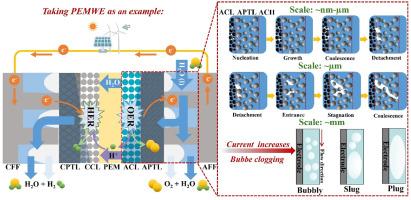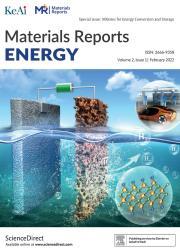绿色制氢水电解槽内多相流的多尺度建模
IF 13.8
引用次数: 0
摘要
水电解槽在绿色制氢中起着至关重要的作用。然而,它们的效率和可扩展性经常受到各种尺度(从纳米尺度到宏观尺度)的气泡动力学的影响。本文探讨了多尺度模型作为可视化多相流和改善水电解槽质量传递的工具。在纳米尺度上,分子动力学(MD)模拟揭示了电极表面特征和润湿性如何影响纳米泡的成核和稳定性。从中尺度来看,流体体积(VOF)和晶格玻尔兹曼方法(LBM)等模型揭示了多孔输运层(ptl)中的气泡输运。这些见解为创新设计提供了灵感,包括梯度孔隙度和亲水-疏水模式,旨在最大限度地降低气体饱和度。在宏观尺度上,VOF模拟阐明了通道内的两相流动状态,显示了流场几何形状和润湿性如何影响气泡放电。此外,人工智能(AI)驱动的代理模型加快了优化过程,允许快速探索通道肋流场和多孔流场设计的结构参数。通过整合这些方法,我们可以将理论见解与实验验证相结合,最终提高水电解槽的性能,降低成本,推进经济实惠的高效制氢。本文章由计算机程序翻译,如有差异,请以英文原文为准。

Multi-scale modeling of the multi-phase flow in water electrolyzers for green hydrogen production
Water electrolyzers play a crucial role in green hydrogen production. However, their efficiency and scalability are often compromised by bubble dynamics across various scales, from nanoscale to macroscale components. This review explores multi-scale modeling as a tool to visualize multi-phase flow and improve mass transport in water electrolyzers. At the nanoscale, molecular dynamics (MD) simulations reveal how electrode surface features and wettability influence nanobubble nucleation and stability. Moving to the mesoscale, models such as volume of fluid (VOF) and lattice Boltzmann method (LBM) shed light on bubble transport in porous transport layers (PTLs). These insights inform innovative designs, including gradient porosity and hydrophilic-hydrophobic patterning, aimed at minimizing gas saturation. At the macroscale, VOF simulations elucidate two-phase flow regimes within channels, showing how flow field geometry and wettability affect bubble discharging. Moreover, artificial intelligence (AI)-driven surrogate models expedite the optimization process, allowing for rapid exploration of structural parameters in channel-rib flow fields and porous flow field designs. By integrating these approaches, we can bridge theoretical insights with experimental validation, ultimately enhancing water electrolyzer performance, reducing costs, and advancing affordable, high-efficiency hydrogen production.
求助全文
通过发布文献求助,成功后即可免费获取论文全文。
去求助
来源期刊

材料导报:能源(英文)
Renewable Energy, Sustainability and the Environment, Nanotechnology
CiteScore
13.00
自引率
0.00%
发文量
0
审稿时长
50 days
 求助内容:
求助内容: 应助结果提醒方式:
应助结果提醒方式:


